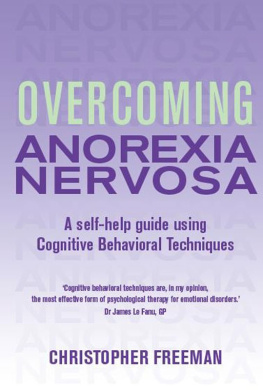Published in 2016 by The Rosen Publishing Group, Inc.
29 East 21st Street, New York, NY 10010
Copyright 2016 by The Rosen Publishing Group, Inc.
First Edition
All rights reserved. No part of this book may be reproduced in any form without permission in writing from the publisher, except by a reviewer.
Library of Congress Cataloging in Publication Data
Walden, Katherine, author.
Conquering anorexia / Katherine Walden and Stephanie Watson. First edition.
pages cm. (Conquering eating disorders)
Audience: Grades 7-12.
Includes bibliographical references and index.
ISBN 978-1-4994-6203-6 (library bound)
1. Anorexia nervosaJuvenile literature. 2. Anorexia nervosaTreatment Juvenile literature. I. Watson, Stephanie, 1969- author. II. Title. RC552.A5W35 2016 616.85'262dc23
2015017870
For many of the images in this book, the people photographed are models. The depictions do not imply actual situations or events.
Manufactured in the United States of America
CHAPTER ONE
An Eating Disorder
CHAPTER TWO
The Roots of Anorexia
CHAPTER THREE
Combatting Risk Factors
CHAPTER FOUR
Symptoms of Anorexia
CHAPTER FIVE
The Recovery Process
This young man is in recovery from anorexia. The disease's full name is actually anorexia nervosa. It is a serious, at times even fatal, illness.
CHAPTER ONE
An Eating Disorder
T he word anorexia literally means loss of appetite. But anorexia is more like self-starvationbecoming so obsessed with losing weight and dieting that you ignore your bodys hunger signals. Although people with anorexia are always hungry, they take pride in denying hunger, feeling more in control and independent. This belief has very dangerous consequences. If anorexia progresses far enough, you can lose massive amounts of body weightenough to cause psychological problems, physical problems, and even death.
Anorexia is a very serious condition. An article in the December 2009 issue of The American Journal of Psychiatry reported that 4 percent of people who are anorexic die as a result of the disease. While anyone can develop anorexia, the group that is most at risk of doing so is young women. In the last decade, health care professionals have found that the disease has become increasingly common in girls under the age of thirteen.
You may have heard the term anorexia used before. Maybe you talked about it in health class, read about it in a magazine, or heard that a celebrity is suffering from the disease. Chances are, anorexia or another eating-related issue probably influences your life or that of a family member or friend right now. You, he, or she might already feel a few of the forces that cause an eating disorder to kick in: insecurity, peer pressure, and societys pressure to be thin.
Though anorexia is a serious disease, a meaningful recovery is possible. Doctors are slowly beginning to better understand anorexia. There are now treatments that can help people who have anorexia gain self-esteem and get healthy.
Healthy and Disordered Eating
Everybody needs food in order to survive and grow. But eating also often has emotional and social importance for people. Its how people bond with each other on holidays, at the movies, and at home. And sometimes there are expectations, even pressures, about what and how much you eat.
If you have a healthy relationship with food, youre able to eat when you are hungry and enjoy what you eat. If you dont have a healthy relationship with food, eating can cause discomfort, guilt, conflicts with others, and even self-hatred.
An eating disorder usually arises when other influences, such as low self-esteem, abuse in the home, or peer pressure, contribute to food becoming an avenue to control something in a persons life or a symptom of other things that might be happening in a persons life. These negative feelings about food become overwhelming enough to interfere with your health and nutrition. Your eating becomes disordered, causing both physical and emotional troubles. Along with anorexia, the most common eating disorders people are diagnosed with are bulimia, binge eating disorder, and OSFED (which is short for Other Specified Feeding and Eating Disorder).
According to a study that was published by the National Institute of Mental Health in 2010, 2.7 percent of teens between the ages of thirteen and eighteen suffer from an eating disorder. While the majority of people with eating disorders are female, the number of males who are suffering from them is increasing. There are many men and boys who go undiagnosed either because of the lack of reporting the disorder or because of misdiagnoses.
People with anorexia and other eating disorders spend a lot of their time thinking aboutand, in the case of anorexia, trying to avoidfood.
Bulimia
People who suffer from bulimia nervosaoften shortened to just bulimiabinge (eat a large quantity of food in a short time) and then purge (eliminate the food, usually by vomiting, using laxatives, or taking diuretics, also known as water pills). The selfesteem of people with bulimia is unhealthily dependent on their weight or body shape. Unlike people with anorexia, though, people with bulimia are not necessarily underweight.
Bulimia does major damage to the body. It can cause ulcers (holes or tears) in the stomach, throat, and mouth. People with bulimia can develop yellow, damaged teeth from the acids brought up into the mouth through repeated vomiting. Abusing laxatives causes painful stomach cramps and weakens the digestive system.
Binge Eating Disorder
People suffering from binge eating disorder eat uncontrollably but dont purge afterward. They consume large amounts of food very quickly whether or not they feel hungry. They usually do this in private and feel unable to control how much or what they eat. People who regularly overeat may forget how to read their bodys normal hunger signals and may not know how to satisfy them.
Binge eating is a feature of several eating disorders. It is a key aspect of both bulimia and binge eating disorder. Some people with anorexia binge eat, too, later purging the food they ate.
OSFED
People whose symptoms do not allow them to be diagnosed with anorexia, bulimia, or binge eating disorder may be diagnosed with Other Specified Feeding and Eating Disorderoften known by its acronym, OSFED. It has several subtypes, including atypical anorexiain which a patient demonstrates many of the features of anorexia but is not significantly underweight.

















